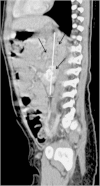Isolated enophthalmos: an uncommon gateway to orbital tumors in pediatrics: 9 month-old female presenting with isolated enophthalmos as the unique sign of a metastatic orbital tumor: a case report
- PMID: 25248293
- PMCID: PMC4181415
- DOI: 10.1186/1471-2431-14-237
Isolated enophthalmos: an uncommon gateway to orbital tumors in pediatrics: 9 month-old female presenting with isolated enophthalmos as the unique sign of a metastatic orbital tumor: a case report
Abstract
Background: If extra-axial proptosis is by far the most common symptom of infantile malignant orbital tumors, enophthalmos is a rare and undocumented sign. We report the first case of a pediatric metastatic orbital tumor revealed by enophthalmos alone.
Case presentation: A 9-month-old girl was diagnosed with isolated right-sided enophthalmos. An orbital tumor was suspected and computed tomography undertaken showing osteolysis and periosteal reaction of orbital walls, malar bones and zygomatic arches. A Thoracic- abdominal CT scan confirmed a stage-4 neuroblastoma.
Conclusion: Enophthalmos can be the sole symptom of an orbital tumor and should lead to immediate imaging assessment. This association is not well known in pediatrics but is relevant to insure the best prognosis.
Figures


Similar articles
-
Orbital neuroblastoma metastasis: A case report and literature review.Medicine (Baltimore). 2019 Sep;98(36):e17038. doi: 10.1097/MD.0000000000017038. Medicine (Baltimore). 2019. PMID: 31490393 Free PMC article. Review.
-
Orbital neurofibromatosis with enophthalmos.Br J Plast Surg. 1993 Jan;46(1):36-8. doi: 10.1016/0007-1226(93)90062-g. Br J Plast Surg. 1993. PMID: 8431739
-
Metastatic Dissemination of a Neuroblastoma.J Pediatr. 2017 Oct;189:232-232.e1. doi: 10.1016/j.jpeds.2017.05.069. Epub 2017 Jun 23. J Pediatr. 2017. PMID: 28651799 No abstract available.
-
Enophthalmos associated with primary breast carcinoma.Orbit. 2002 Dec;21(4):307-10. doi: 10.1076/orbi.21.4.307.8559. Orbit. 2002. PMID: 12610771
-
Neuroblastoma in the adult. Case report.Cir Cir. 2009 Sep-Oct;77(5):397-401. Cir Cir. 2009. PMID: 19944030 Review.
References
Pre-publication history
-
- The pre-publication history for this paper can be accessed here:http://www.biomedcentral.com/1471-2431/14/237/prepub
Publication types
MeSH terms
LinkOut - more resources
Full Text Sources
Other Literature Sources
Medical

